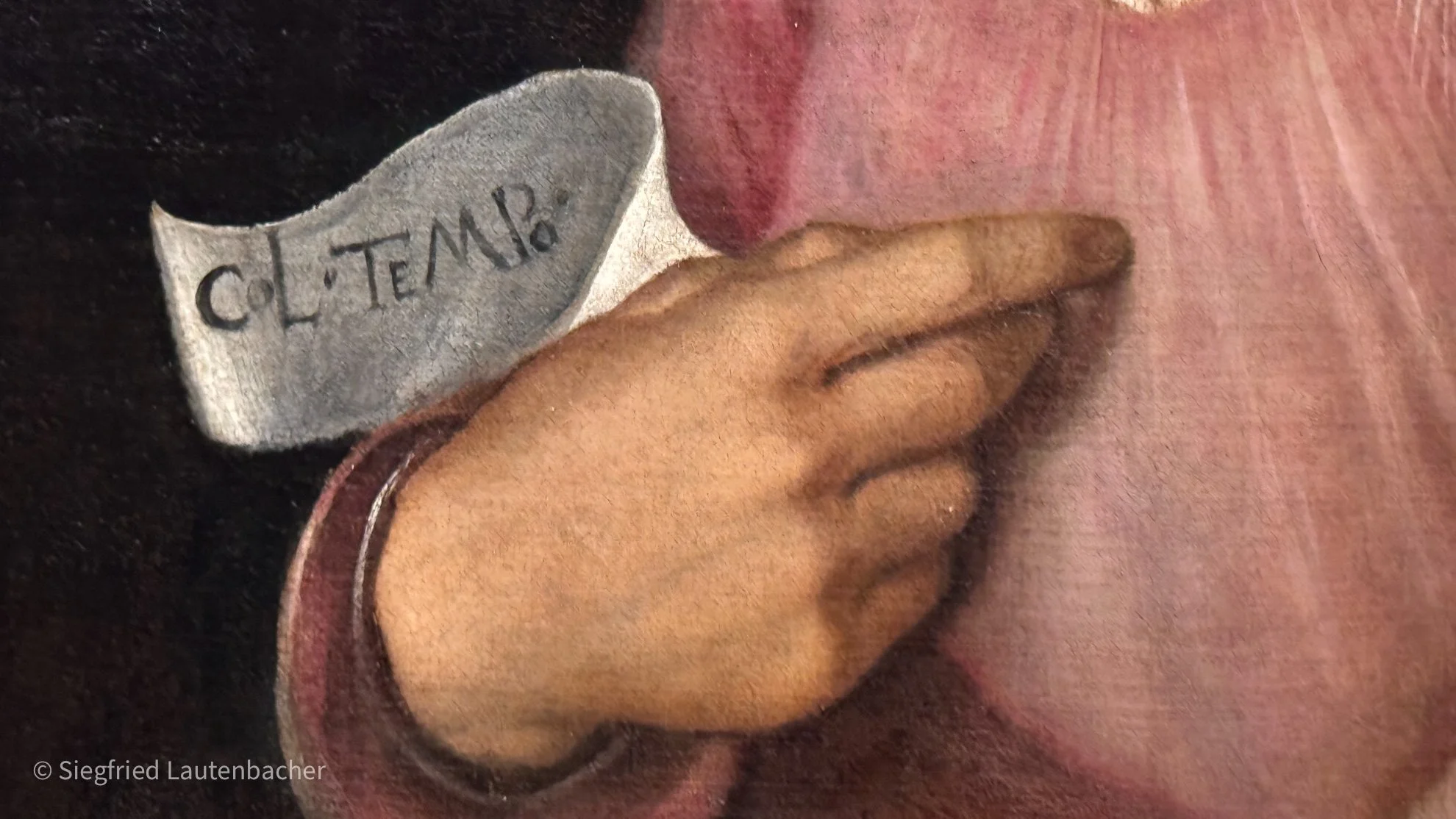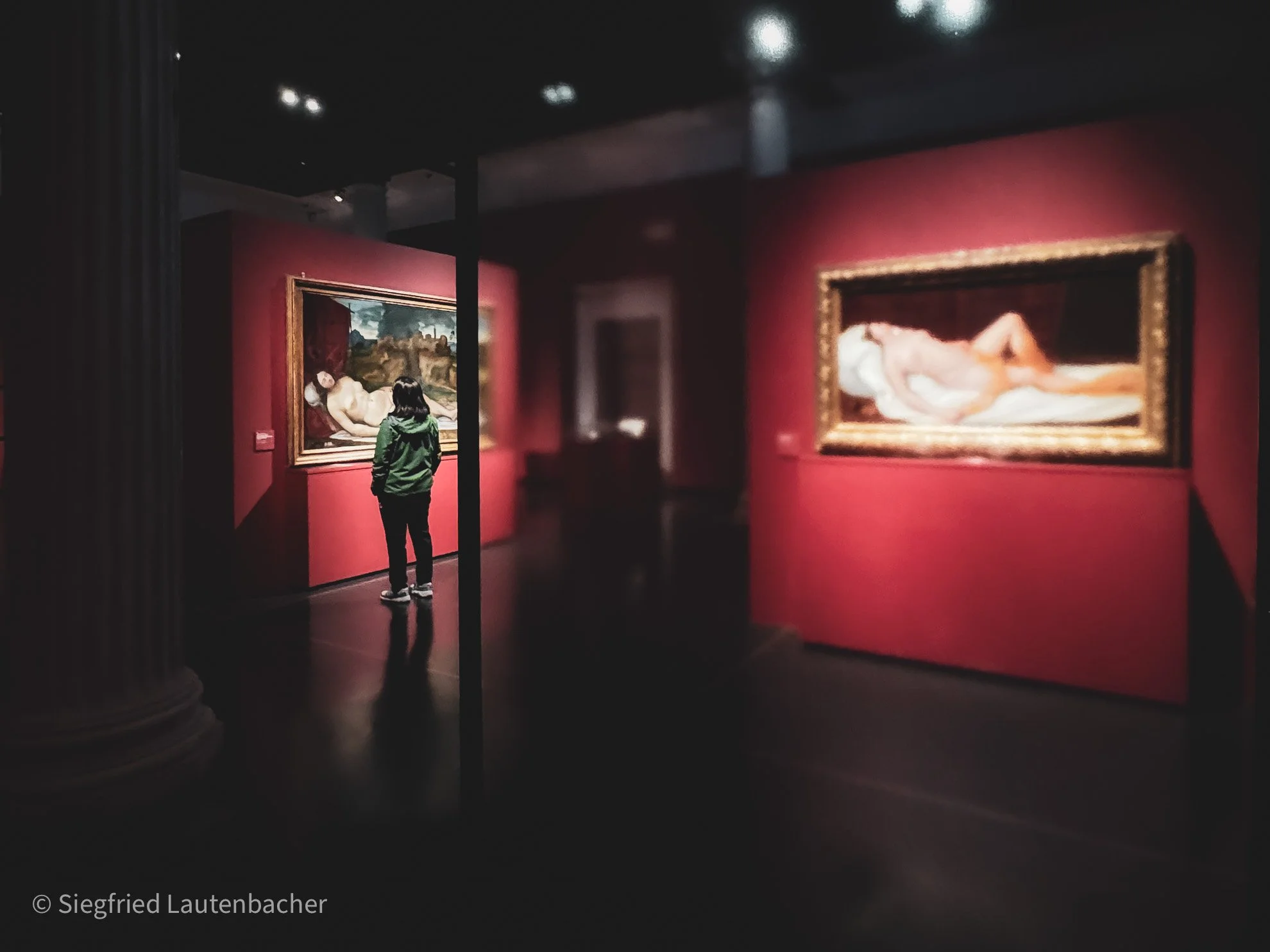Endangered Bodies – Anatomy of a City: 'Corpi Moderni' in Venice
"COL TEMPO". Detail from Giorgione's "La Vecchia". Gallerie dell'Accademia, Venice. April 2025
In the chambers of the Gallerie dell'Accademia, one of the most remarkable art exhibitions of the year is currently unfolding: “Corpi Moderni. La costruzione del corpo nella Venezia del Rinascimento”. I have already visited this extraordinary show twice in a city whose own urban body is visibly collapsing.
The Body as Cultural Construct – in Art and Urban Fabric
What distinguishes this exhibition from conventional Renaissance displays is its interdisciplinary approach. The human body is understood here as a complex cultural construct, shaped by science, art and social practices – a metaphor readily applicable to Venice itself. For this city, too, is a cultural “corpus”, formed through centuries of human intervention in the lagoon, now threatened by climate change and overwhelming tourism, which attacks the urban substance like a modern disease.
Leonardo's Vitruvian Man: Perfect Proportion in a City That Has Lost Its Balance
The centrepiece of the exhibition, Leonardo's “Vitruvian Man”, is on public display after a six-year absence. The fragility of this iconic sheet, which can rarely be presented, symbolically mirrors Venice's vulnerability. Whilst Leonardo designed the perfect, harmonious body, the lagoon city today struggles for survival in the face of rising sea levels and tourist masses flooding through its narrow streets daily.
Leonardo da Vinci “L’uomo vitruviano” in “Corpi Moderni” Gallerie dell’Accademia. Venice April 2025
This juxtaposition is further enhanced by the curatorial decision to place Dürer's unsparing nude self-portrait alongside Leonardo's geometrically perfect body. A further parallel emerges here, as this contrast finds its counterpart in the contradiction between the idealised image of Venice in visitors' minds and the actual reality of a city marked by mass tourism.
Three Perspectives on Body and City: Knowing, Desiring, Representing
The exhibition's tripartite structure can also be read as a reflection on Venice's urban body:
In the perspective “The Revealed Body: Knowing”, we encounter the scientific gaze of the Renaissance. Just as Renaissance anatomists looked beneath the skin, today we must look beneath Venice's tourist surface to recognise the threatened lifeblood of the city: over 70% of historic dwellings have now been converted into holiday flats – a vicious cycle in which locals rent out their homes and move to the mainland. The consequence: where bakeries, greengrocers, and craftsmen once characterised daily life, souvenir shops and establishments for day-trippers now dominate.
The perspective “The Naked Body: Desiring” addresses the body as an object of desire – a parallel to today's commodification of Venice as a consumer good for global tourism. The city is “undressed”, its intimacy offered to the tourist gaze, whilst simultaneously its authentic social fabric erodes. A drastic example of this appropriation is the wedding of Amazon founder Jeff Bezos planned for June, who will commandeer the city with 300 illustrious guests – Venice as mere backdrop for the staging of private wealth, whilst residents are relegated to extras in a glamorous spectacle.
The section “The Constructed Body: Self-Representation” finds its echo in Venice's efforts to reinvent and assert itself. The mechanical prostheses for war casualties in the exhibition recall modern interventions to protect the city – from the controversial MOSE flood barriers to the apparent attempts to regulate tourist flows and revitalise urban life, which merely serve to appease UNESCO officials.
Coded Gestures: The Deception Behind “Protective Measures”
The exhibition impressively demonstrates how the body in Renaissance Venice was regulated through complex social codes. The fascinating fold-out book with the intimate gondola scene and documents regarding the touching of the female breast as a formal act of marriage before the Council of Trent reveal how strongly bodily gestures were ritualised.
Corpi Moderni. Gallerie dellAccademia. Venice April 2025
I have the impression that today's "protective measures" for Venice follow a similar principle of coding – albeit with a cynical twist. Whilst the current mayor – who, tellingly, lives on the mainland – stages access restrictions and entrance fees as saving the city, we residents see through this transparent political theatre.
The supposed protective mechanisms do not truly serve to preserve a living Venice, but rather further transform our city into a backdrop for affluent tourists. For the city administration, the remaining Venetians increasingly appear to be an inconvenience that hinders the smooth operation of the tourism industry. One suspects: Would they not prefer a Venice without Venetians – a perfectly staged historical theme park where no troublesome locals demand affordable housing, functioning infrastructure or simply quality of life?
The Gallerie dell'Accademia: A Space for Reflection
In light of these developments, the Gallerie dell'Accademia offers a remarkable contrast. Here, amidst the tourist hustle, a space opens up where not rapid consumption, but engagement with cultural heritage takes precedence.
The thoughtful staging of the "Corpi Moderni" exhibition with its red walls, which echo Venetian colouring, creates a space where Venice's cultural depth remains palpable. Particularly noteworthy are the transparent glass windows in front of some exhibits – they slow down the gaze, compelling contemplation rather than hasty consumption of art.
Corpi Moderni. Gallerie dellAccademia. Venice April 2025
This curatorial decision stands in sharp contrast to the “selfie-before-sight” culture that dominates outside the museum. Here, in the remarkably quiet halls of the Accademia, one can still sense what Venice has to offer beyond its role as a global tourism backdrop: a space for cultural encounters and aesthetic experiences not reduced to Instagram-worthiness.
“Col Tempo” – With Time: The Poignant Final Note
The exhibition deliberately concludes with a work also found in the permanent collection of the Accademia: Giorgione's portrait of an elderly woman holding a simple note reading “COL TEMPO” (“With Time”). Positioned as the final exhibit, this painting acquires special significance – it becomes the thoughtful epilogue of the entire show.
Giorgione “La Veccia” in “Corpi Moderni” Gallerie dell’Accademia Venice. April 2025
Through this placement, the curators create a clear message: After all the idealised bodies, scientific studies and symbol-laden representations, the unvarnished reality of ageing stands at the end. The unpretentious portrayal, neither embellished nor dramatised, seems to speak directly to Venice's current situation.
For like the aged body in the painting, Venice too bears the traces of its long history – signs not of decay, but of life itself. The city ages, changes, adapts. The “Corpi Moderni” exhibition reminds us that bodies – whether human or urban – are not static ideals, but living organisms whose beauty also lies in their transience.
Perhaps a lesson for our approach to Venice lies here: Rather than treating the city as an unchangeable museum of itself, we might conceive of it as a living body requiring sensitive care rather than exploitation. “Col Tempo” – with time – could become the guiding principle for a more sustainable relationship with this unique urban body which, despite all threats, still stands for cultural depth, sensual beauty and existential fragility.
Exhibition gallery with mirrored surfaces reflecting visitors and works. "Corpi Moderni", Gallerie dell'Accademia, Venice. April 2025





